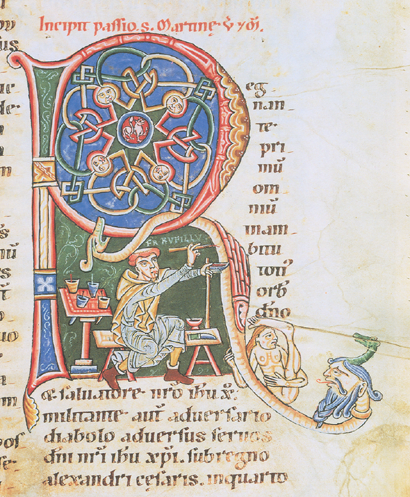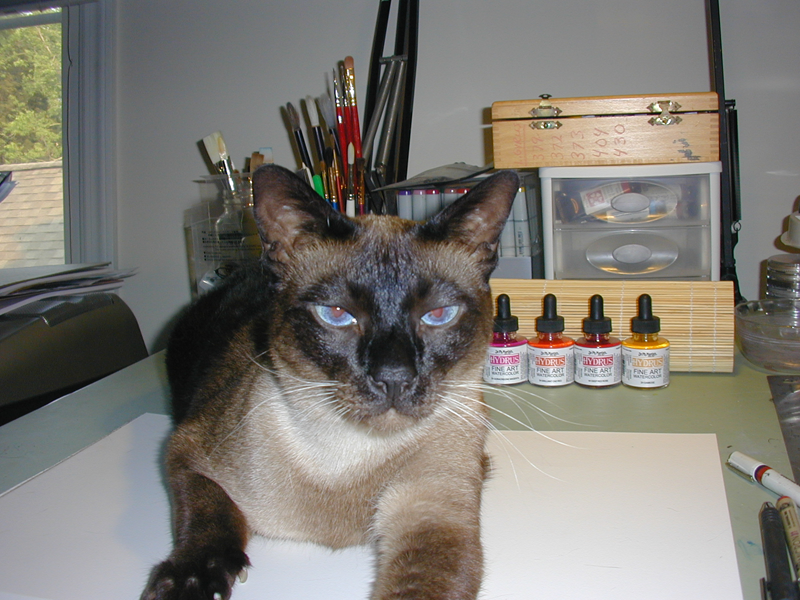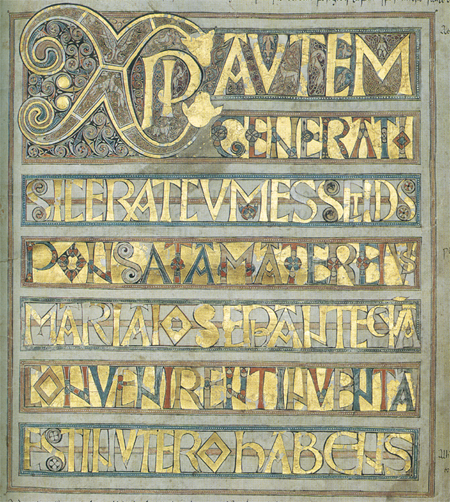Category — Tutorial
Making Your Own Illuminations Part 2 – Superman Comics, Medieval Illuminations and Miniatures

Frater Rufillus of Weissenau self-portrait in decorated initial from Medieval Illuminators and Their Methods of Work
Did I get your attention with the title of this lesson? I hope so. Besides medieval history, one of my interests is comic book art. Until recently, when digital methods superseded hand-drawn art, comic books were made in the same way that medieval artists created their magnificent illuminated books. There are three parts to creating the figure art in a comic book. The penciller draws the comic in the familiar framed format of the comic book, the inker inks over the lines drawn by the penciller and the colorist colors the image to produce final art. One person or many people may be involved in this process. This is exactly how medieval artists created their books and it is how we will create our illuminated writing.
This will require a few simple tools. The first, of course, is paper. My personal preference is 500 series Strathmore Bristol plate surface. Your choice should be made based upon your materials. I use watercolor, ink, some acrylics and colored pencils for my writing. They all work well on this surface. Since this is all for fun and for learning and for making mistakes, feel free to use whatever you have on hand. If you decide to continue beyond these simple tutorials, then you can purchase more expensive supplies at that time.
Many folks feel great anxiety when faced with drawing anything. If this is you, you might want to consider purchasing transfer paper. If you’re scared, intimidated and freaked, relax. You can choose images you want to replicate and transfer them to your drawing surface using carbon paper. Something like was done in medieval times and you can do it, too. You can even do it on the cheap. Take a piece of cheap printer/copier paper and cover one side with lead from a 2B pencil. This is a little messy but it will allow you to carbon transfer your image.
Planning the writing, requires ruling the page. A ruler will suffice. A ruler and a triangle are better. In addition to the basic tools, I have a series of french curves and ellipsoid templates. These are very useful and speed the process.
Finally, we come to the actual tools used to put design and color on the page. You will need a pencil, not too hard and not too soft. You will need something to make a permanent fine black line such as a Pigma Micron or Copic multiliner/marker. I use a fountain pen and/or a dip pen with Noodler’s Ink for my writing. You don’t need to get fancy and a simple finepoint black Sharpie marker will do. Use what you have and keep it cheap.
I’ve left color and illuminating gold for last. How you do this depends on what effect you want to achieve. Is this just a fun exercise and you’re doing it all on the cheap? Fine, use some watercolor and/or colored pencil. Are you trying for the look of an old book or do you want your writing to have the look of a brand new manuscript? What we see today are faded versions of the original writing. The colors were brilliant and intense when the original pages were created but the palette was limited. Look at the decorated letter at the start of this tutorial. Notice the little bowls of color the artist is using. You will need only a basic color set in whatever media you choose.
Derwent Inktense Watercolor Pencils
Do you want it all in a simple package? Derwent Inktense Pencils are fantastic tools for creating bright, bold colors and outlining with “ink”. The smallest set will provide all of the colors you need. The very nice part about these pencils is that they come with a black (ink) outlining pencil that is waterproof. It’s all there except for the illuminating gold. I use these pencils all the time and you can get many different effects with them.
Dr. Ph. Martin’s Hydrus Fine Art Watercolor Sets
I use Dr. Ph. Martin’s Hydrus Watercolor to color my writing when I want striking brilliant color.
Illuminating Gold
I use a gold paint from Golden Acrylics called “Iridescent Gold Deep (Fine)” for illuminating my writing. To start, I suggest you use one of the many available metallic gel markers. They’re cheap and easy to find.
That covers everything you will need to get started. In the next lesson, we’ll start looking at putting design on the page. Have fun with this. You might find a hobby that will last a lifetime. Finally, invite a friend to try it with you. It’s more fun that way. Here’s my friend. He’s always eager to give me a helping hand….
May 22, 2011 2 Comments
Making Your Own Illuminations Part 1 – Let the Fun Begin
This is not going to be a series of tutorials on how to create illuminations as they were done in medieval times. This is going to be a descriptive tutorial on how to create the illusion of medieval writing and illuminations using modern papers and materials.
I recommend two reference books for our discussions.
1. The Bible of Illuminated Letters: A Treasury of Decorative Calligraphy [BIBLE OF ILLUMINATED LETTERS] [Spiral] This is a wonderful book that provides precise and detailed descriptions of how to replicate what the medievalists did. If you want a real challenge and are dedicated to learning the craft, this is the book for you.
2. Medieval Illuminators and Their Methods of Work This book has many examples of partially completed manuscripts that allow you to see exactly how pages were created. It has a small section early in the book that gives a concise description of what we know about materials, methods and technique.
To get the most out of these tutorials, I suggest you think of something you wish to write as an illuminated text and follow the process with me. I’m going to create a new header image for this site. I’ve chosen a model for my illumination. I’m going to style my illumination after the spectacular Codex Aureus from the eighth century. Here is my inspiration:
Think about what you want to do. It doesn’t have to be formal or fancy. It might be something as simple as a page in your art journal or sketchbook. In part 2, I’m going to discuss possible materials you might want to use for your illumination.
May 15, 2011 1 Comment



